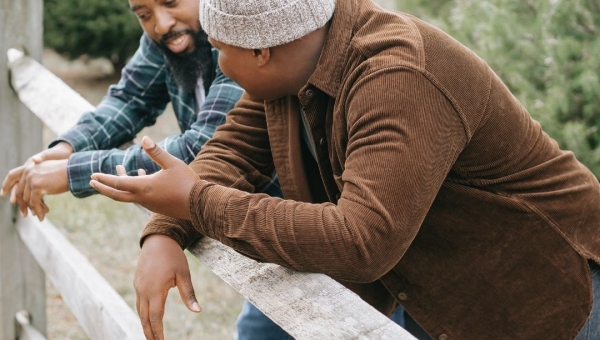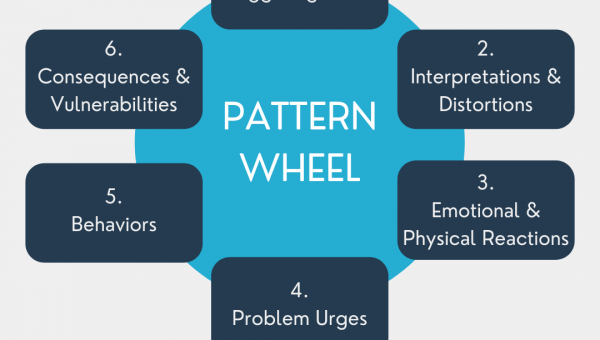FROM THE BLOG
Stay updated on what is happening in the world of psychology and counseling.

Keeping Your Balance with Growth, Healing, and Maintenance
So far you have been on quite the journey! Earlier, we learned that trauma has a way of throwing everything off balance, including our thoughts, our feelings, our behaviors, and our relationships. Sin...
Read More
Ending the Drama Cycle
So far, we have learned a lot of information about how to improve relationships. For example, you have learned to assert, to appreciate, and to apologize with the Adult Voice. You have also learned to...
Read More
Learning the Love Languages
So far, we have learned some basic social skills to balance your relationships. For example, you have learned to be assertive, which is the middle path between passive and aggressive. You have also le...
Read More
DEAR Adult: Appreciate and Apologize
Congratulations! You have just learned how to be more assertive in four simple steps: Describe, Express, Assert, and Reinforce. Of course, healthy relationships involve much more than just walking aro...
Read More
DEAR Adult: Assert
Regardless of how you are wired as a person, and regardless of how someone else is wired as a person, there are three A’s which are indispensable for human interactions: Assert, Appreciate, Apologize....
Read More
Relationship Styles
Before we learn specific strategies on how to improve our relationship skills, it will be helpful to first learn about the different relationship styles that people have in the first place.
Moving To...
Read More
Restoring Balance with Relationships
In earlier blog posts, you learned that trauma has a way of throwing us off balance. Just about everything can get thrown off balance by trauma: our thoughts, our feelings, and our actions. And since ...
Read More
Fertilize with ABC’s
Would you ever plant a garden in the spring, and just abandon it till the end of the summer? Even if you planted the right seeds, what kind of outcome would you expect if you did absolutely nothing to...
Read More
Trouble Shooting
When it comes to the game of life, do you have trouble shooting? Or have you learned to shoot your troubles? Now I am not a violent person, but please work with my analogy: If we are going to protect ...
Read More
Acting Opposite
Did you ever notice that reacting to your emotions can actually make them worse? For example, let’s suppose that you are really ticked off. And when you get ticked off, you clench your fists and raise...
Read More
Restoring Balance with Emotions - Check Your Soil
Sometimes when we have really intense emotions, it’s because we are reacting to either incomplete or inaccurate information. In other words, maybe some of the information is missing, or maybe some of ...
Read More
Restoring Balance with Emotions - Weed the Myths
Have you ever heard a myth? Myths are often used to explain why certain things are the way they are, and they tend to get told over and over again. Myths often combine some things that are true with o...
Read More
Restoring Balance with Emotions - Sow Your Seeds!
One of the best ways to nurture your emotions (believe it or not) is to take care of your body.
Think of the last time you were sick. Or the last time you missed a meal. Or the last time you ate way ...
Read More
Restoring Balance with Emotions – Your Garden
In a previous blog post, we learned how to use the Balanced Mind to bring balance to our Thinking Mind. In this post, we will learn how to use the Balanced Mind to bring balance to our Feeling Mind.
...
Read More
Playing Your DS
I would like to introduce a thinking skill that is very simple to learn and use.
I call this skill Dialectical Synonyms, or DS for short.
If you remember from English class, synonyms are two words t...
Read More
Working the TOM
In the previous blog post, we learned that certain thoughts can sometimes provoke certain emotions which in turn can sometimes provoke certain actions. That’s why it’s so important to figure out what’...
Read More
Stomping the ANT’s
Have you ever looked at yourself in one of those funny mirrors? Whose image did you see? It was you, of course. After all, it wasn’t George Washington or Michael Jordan staring back in the mirror—it w...
Read More
What's in your TEA?
Psychologists have long noticed that thoughts, emotions, and actions all influence each other. Since the 1960’s, psychologists have especially focused on how certain thoughts can inspire certain emoti...
Read More
Restoring Balance with Thoughts
We’ve already learned about the three minds: The Thinking Mind, the Feeling Mind, and the Balanced Mind. Do you remember how both our thoughts and our feelings can get off balance when we are not usin...
Read More
The Coping Pantheon
A sequence we have seen repeatedly throughout these blogs is this: Awareness, Acceptance, Action. As we have already learned, awareness and acceptance alone can often transform our lives from unbearab...
Read More
Extreme Acceptance
Not everything that happens to us in life is something we signed up for. There are some things in the past we desperately wish never happened to us. There are other things in the present we desperatel...
Read More
Restoring Balance With Better Coping
In the previous blog series, we learned all about mindfulness. In particular, we learned that applied mindfulness involves a three-step sequence: Awareness, Acceptance, Action. First we need to become...
Read More
Overcoming Blind Spots
So far in this blog series, we have further developed the themes of awareness, acceptance, and action. We have learned that we cannot accept difficult facts or make difficult changes until we first ov...
Read More
Levels Of Action
In the previous blog, we talked about five stages of acceptance. Now we are going to talk about five stages of action. Do you remember why we talked about acceptance first? Because we can’t change rea...
Read More
Levels of Acceptance
All of us struggle at times to accept the reality we have been dealt. Sometimes reality is so painful we would rather pretend that some things do not exist or never happened. However, there are many r...
Read More
Levels of Awareness
Have you ever noticed something about someone else before that person did? Maybe that person has a funny tic or says the work “like” way too many times in one sentence. On the flip side, have you ever...
Read More
Intro to Mindfulness: Part III
In the previous blog, we discussed the first three components of mindfulness:
1. To be aware2. On purpose3. In the present
However, there is one more component of mindfulness: “Without judging.” Now...
Read More
Intro to Mindfulness: Part II
When people hear the word mindfulness, sometimes they think of meditation or great mystical experiences. However, the concept of mindfulness is actually quite simple and ordinary. In this blog, I woul...
Read More
Intro to Mindfulness: Part I
Perhaps you have heard the term “mindful.” “Mindfulness” seems to be the latest buzzword in treatment circles, not to mention society in general. But actually, the concept of mindfulness has been arou...
Read More
The Effects of Trauma: Part 2
As previously mentioned, trauma has a way of throwing our lives out of sync in many different ways and directions. In this blog, we will focus on how trauma affects two mental processes: awareness and...
Read More
The Effects of Trauma: Part I
Trauma affects different people in different ways. But there’s one thing trauma always does: It throws you off balance. In fact, the effects of trauma can you leave you feeling so out of sync that you...
Read More
Trauma Stabilization: Part 10 of 10
Summary (Part 10 of 10)
Ongoing trauma results in overstimulation of both the sympathetic and parasympathetic nervous systems (accelerator and brake), resulting in a variety of responses that are eit...
Read More
Trauma Stabilization: Part 9 of 10
DEAR Adult: One Path to Interpersonal Effectiveness (Part 9 of 10)
Whereas all the other skills mentioned so far are about self-regulation, interpersonal effectiveness inherently involves both the se...
Read More
Trauma Stabilization: Part 8 of 10
Working the TOM: One Path to Dialectical Thinking (Part 8 of 10)
Dialectical thinking is all about letting go of the extremes, learning to think more in the middle, learning to be more flexible with ...
Read More
Trauma Stabilization: Part 7 of 10
Sow Your SEEDS: One Path to Emotion Regulation (Part 7 of 10)
Whereas distress tolerance refers to short-term coping in the moment, emotion regulation refers to a long-term lifestyle change that will...
Read More
Trauma Stabilization: Part 6 of 10
TIP the Balance: One Path to Distress Tolerance (Part 6 of 10)
DBT distress tolerance is all about learning to cope in the moment without making it worse. It is about replacing impulsive, addict...
Read More
Trauma Stabilization: Part 5 of 10
The RAIN Dance: One Path to Mindfulness (Part 5 of 10)
Mindfulness, by definition, is always a combination of both awareness and acceptance. The RAIN dance helps clients increase both awareness and a...
Read More
Trauma Stabilization: Part 4 of 10
Restoring Balance (Part 4 of 10)
Dialectical behavior therapy (DBT), which was developed by Marsha Linehan, is all about reconciling “dialectical dilemmas” (binary extremes resulting in dysfunction) ...
Read More
Trauma Stabilization: Part 3 of 10
A Breakdown in Dialectics (Part 3 of 10)
This driving metaphor describes what happens to people who have experienced chronic trauma: too much accelerating, too much braking, and loss of social engage...
Read More
Trauma Stabilization: Part 2 of 10
The Two Pedals (Part 2 of 10)
Think of the sympathetic nervous system as the accelerator and the parasympathetic nervous system as the brakes. As we drive down the highway, we need both of these func...
Read More
Trauma Stabilization: Part 1 of 10
Trauma stabilization through polyvagal theory and DBT
From article published by the American Counseling Association on September 14, 2021
By Kirby Reutter
Introduction (Part 1 of 10)
From my persp...
Read More
Pattern Wheel
The Diary Card is a great tool to help you remember your skills as well as a great tracking device to help you monitor your daily ups and downs. But what happens when you’re really stuck? What do you ...
Read More
The Diary Card
Now that we have learned all of these great skills, we need a way to make sure we are applying them on a daily basis, starting with the very first skill we learned: mindfulness. The Diary Card is a si...
Read More

